Primordial Deities of Ancient Greek Mythology
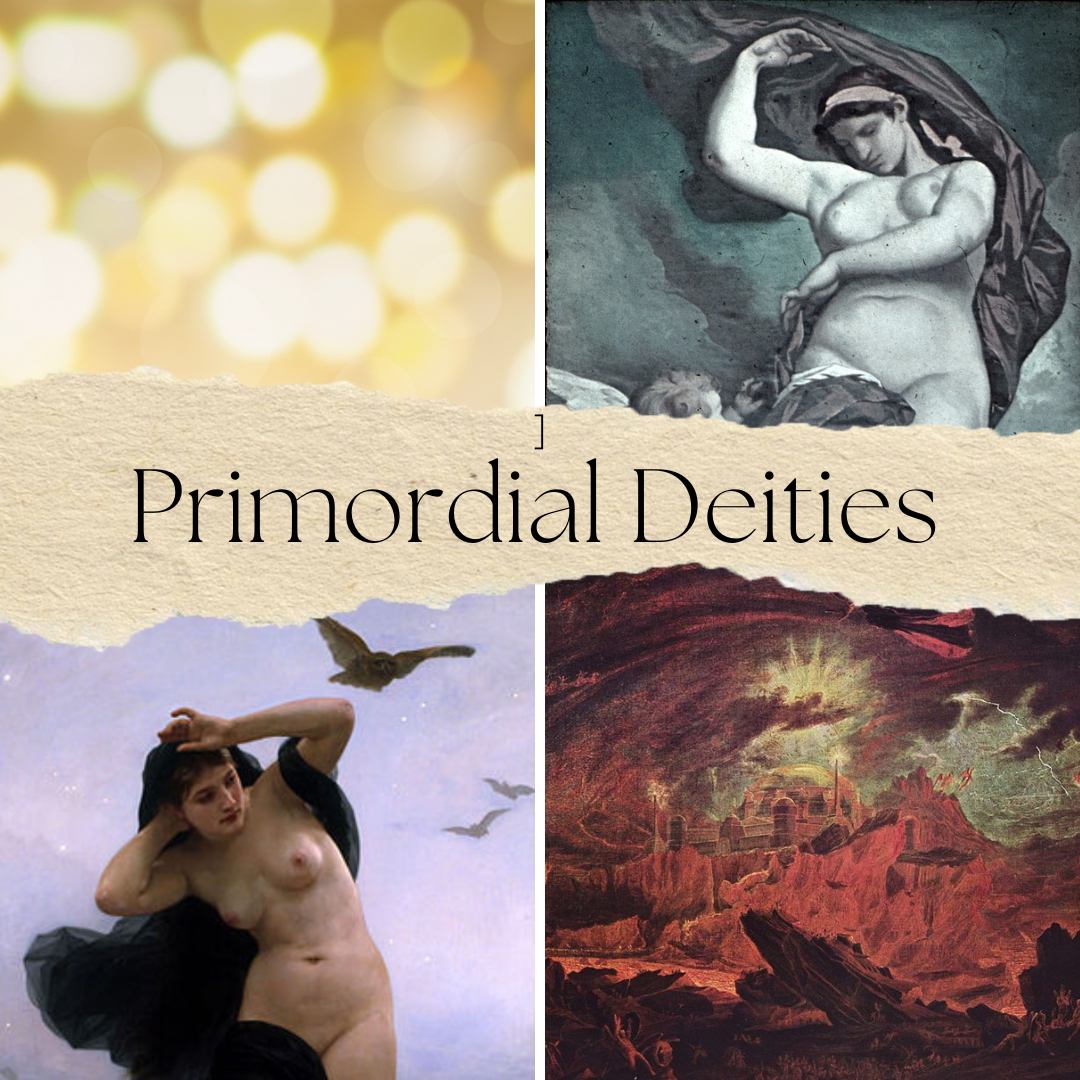
Ancient Greek scholars disagree about which deities existed before Gaea and Uranus, but most agree that Chaos was there before anything else existed.

Chaos was a dark emptiness. Like in the Biblical story of creation, this darkness existed before the emergence of Gaea, the first goddess. According to the Biblical story of creation, Darkness was there before the Biblical God created the world.
1 In the beginning God created the heavens and the earth. 2 The earth was formless and void, darkness was over the surface of the deep, and the Spirit of God was moving[ over the surface of the water. Genesis 1:1-2
According to the Bible, the world was also always wet. The Ancient Greeks believed that before the rest of the world was created, the world was wet. They called that primordial wetness Oceanus, Scholars disagree about how Oceanus was formed, but most seem to agree that this great wetness was at least almost always there.
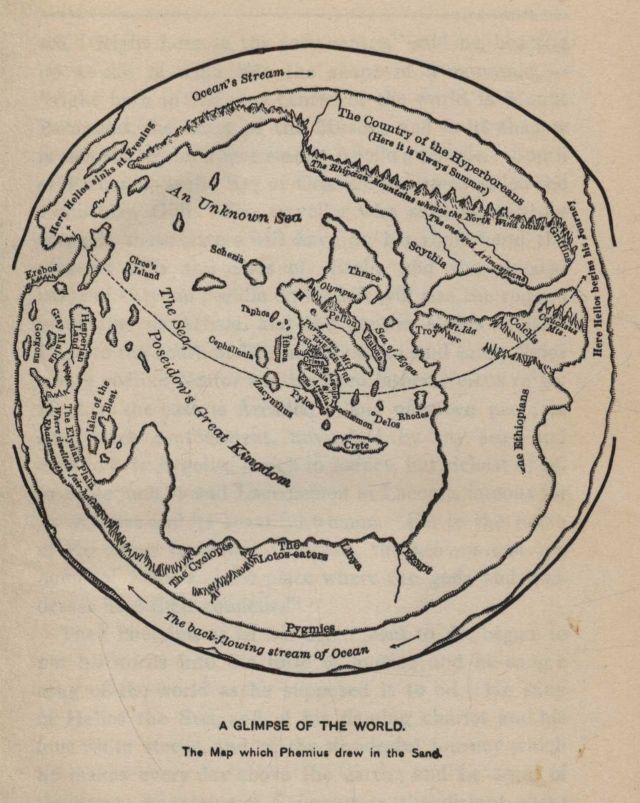
Image Credit: The Golden Age by James Baldwin, 1827.
The ancient Greeks believed that from the earliest history, a great stream. of water encircled the world.
According to the Biblical account of creation, the world was always dark and wet. Genesis 1:1-2
Chaos was the ultimate darkness, but there were levels of lesser darkness.
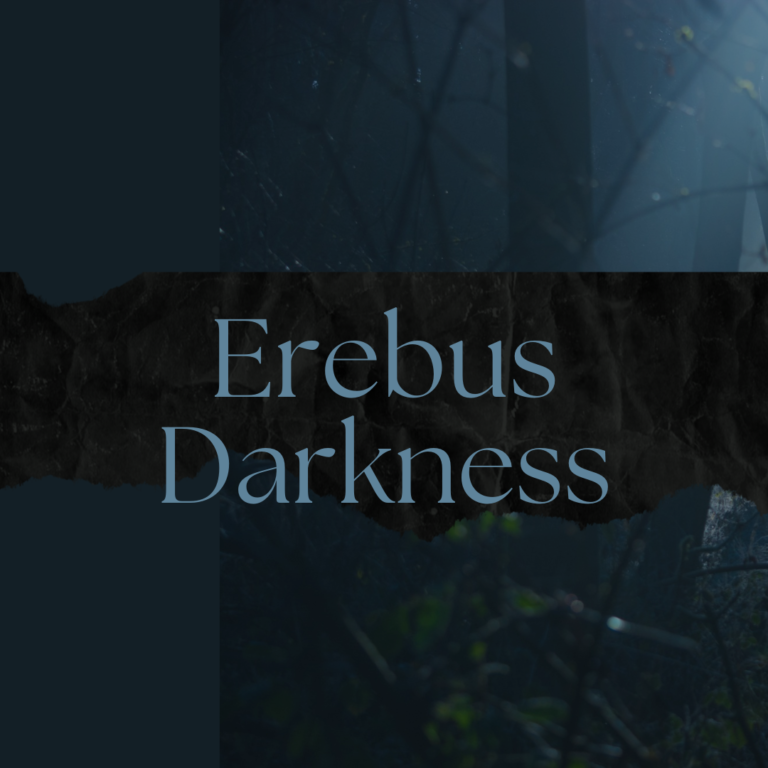
It is interesting that thousands of years before Christ was born, the Ancient Greeks were able to distinguish Darkness from Night. Erebus was the god of darkness, He was not Chaos–that great darkness that had always been in existence, and he was not the night.

The goddess Nyx was the goddess of the night. The Night was another of the primordial deities, but Nyx was not the omnipresent darkness of Chaos,
It is interesting that in the Biblical account of creation, the night was created after there was the presence of darkness.
3 God said, “Let there be light,” and there was light. 4 God saw that the light was good, and God separated the light from the darkness. 5 God called the light Day, and the darkness He called Night. So the evening and the morning were the first day.
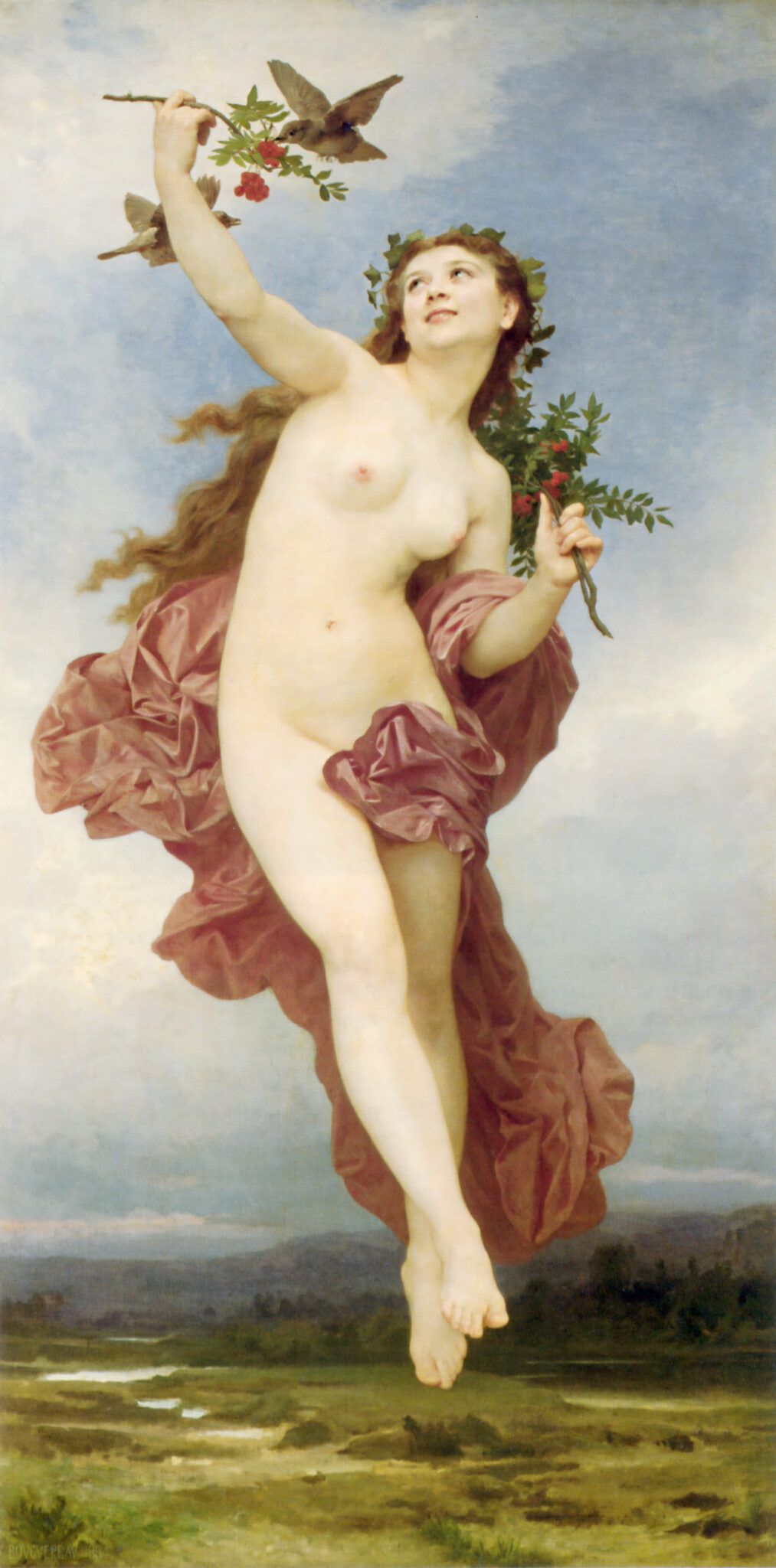
Oddly, Hemera’s parents were Erebus or Darkness and Nyx or Night.

Again, it is interesting that the Ancient Greeks were able to distinguish varying degrees of Light. Aether was the elemental source of light, and she was a primordial deity.
In the Biblical account of creation, God created Light before He created anything else. That first light was not the sun, the moon, or the stars–they were created later. in my opinion, Aether is like the first Light of God’s creation.
1 In the beginning God created the heavens and the earth. 2 The earth was formless and void, darkness was over the surface of the deep, and the Spirit of God was moving over the surface of the water.
3 God said, “Let there be light,” and there was light. 4 God saw that the light was good, and God separated the light from the darkness. 5 God called the light Day, and the darkness He called Night. So the evening and the morning were the first day. Genesis 1: 1-5

Tartarus was the primordial region of the underworld. Hades ruled over one region of the underworld, but Hades was not a primordial god.
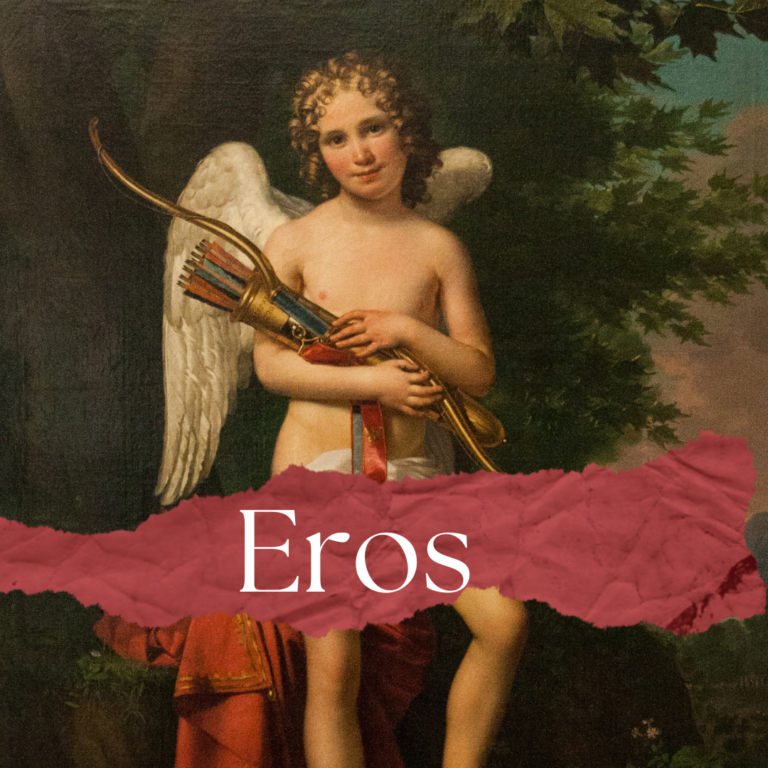
It is believed that Eros also existed before the evolution of Gaea. It is believed that the force of Eros caused Gaea’s longing for a mate. Subsequently, Gaea created Uranus to be her mate. Eros was the god of love. In ancient Roman Mythology, Cupid was the counterpart of Eros.
First Dynasty of Ancient Greek Mythology
According to E. M. Berens, Uranus and Gaea were the leaders of the First Dynasty of Ancient Greek Mythology.
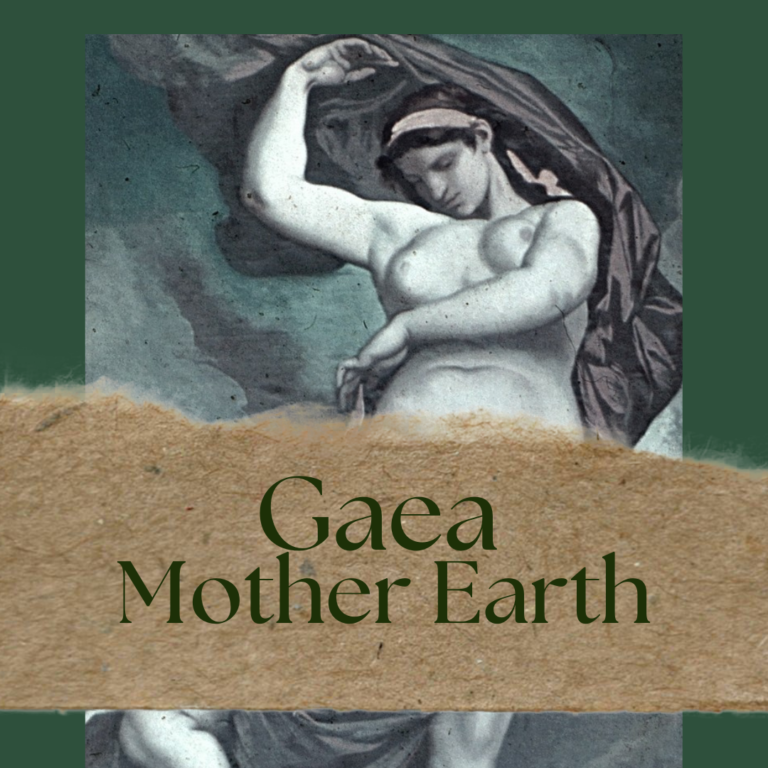
Gaea was the first of Ancient Greece’s gods and goddesses. She was a primordial deity. Most scholars believe that Gaea [the goddess of Earth] arose from the watery depths of Chaos.
In the Biblical account of creation, Earth evolved in a similar way
9 Then God said, “Let the waters under the heavens be gathered together into one place, and let the dry land appear.” And it was so. 10 God called the dry land Earth, and the gathering together of the waters He called Seas. Then God saw that it was good. Genesis 1:9
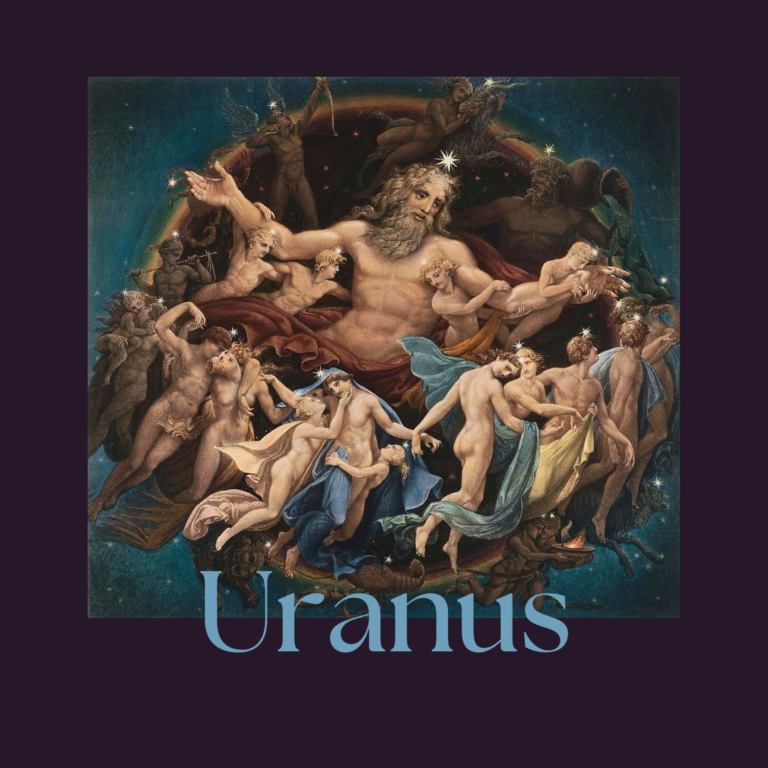
Gaea was alone and she pulled her mate from somewhere within herself. Uranus was a Primordial Deity. He was both the husband and firstborn of Gaea. Uranus is the god of the heavens, and Gaea is the goddess of Earth.
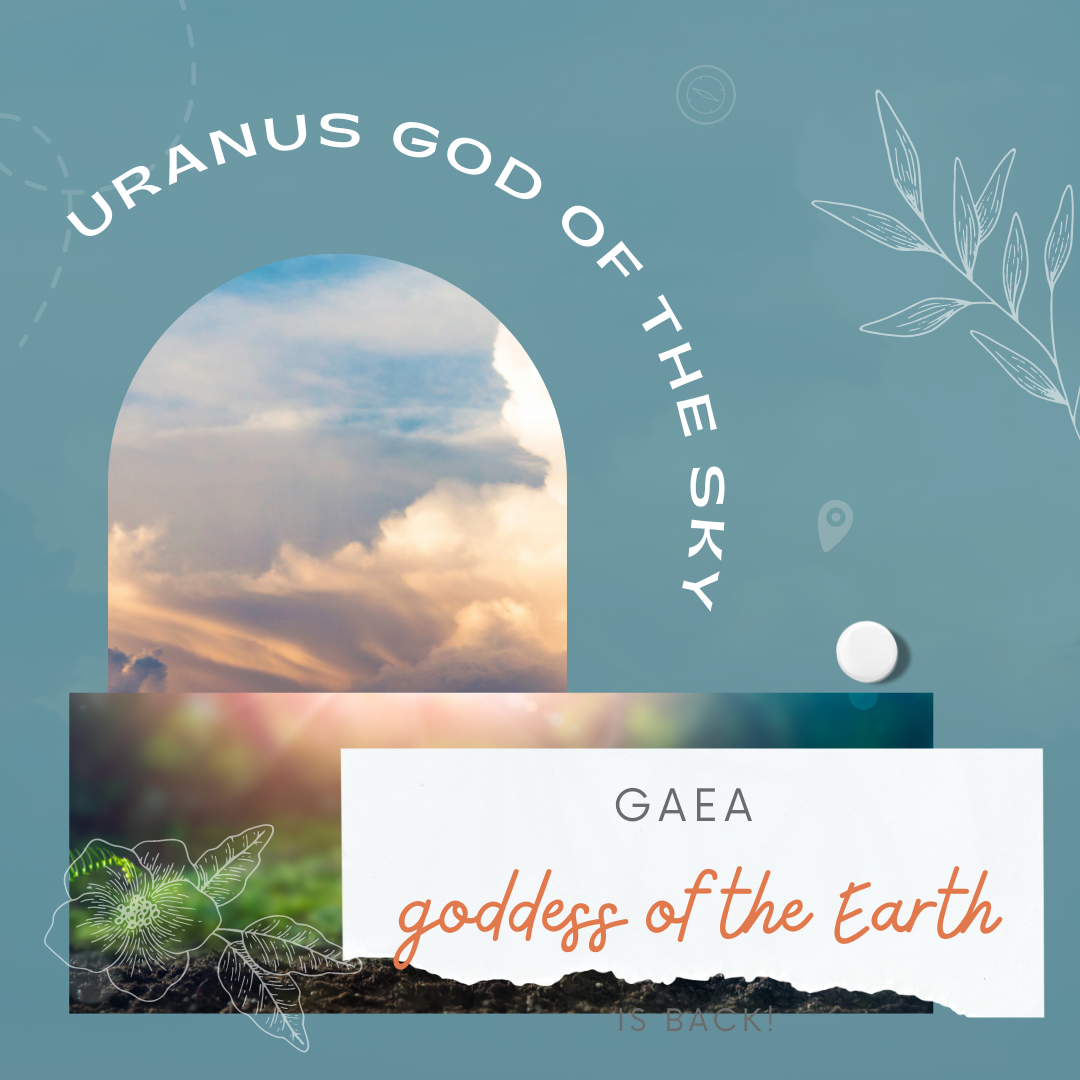
The Biblical account of creation seems to coincide with the notion that the early world consisted of heaven an earth:
6 Then God said, “Let there be an expanse in the midst of the waters, and let it separate the waters from the waters.” 7 So God made the expanse and separated the waters which were under the expanse from the waters which were above the expanse. And it was so. 8 God called the expanse Heaven. So the evening and the morning were the second day.
9 Then God said, “Let the waters under the heavens be gathered together into one place, and let the dry land appear.” And it was so. 10 God called the dry land Earth, and the gathering together of the waters He called Seas. Then God saw that it was good. Genesis 1:6-10
The sky hovers above the earth. Sky and Earth are two separate entities that are linked in their positions.

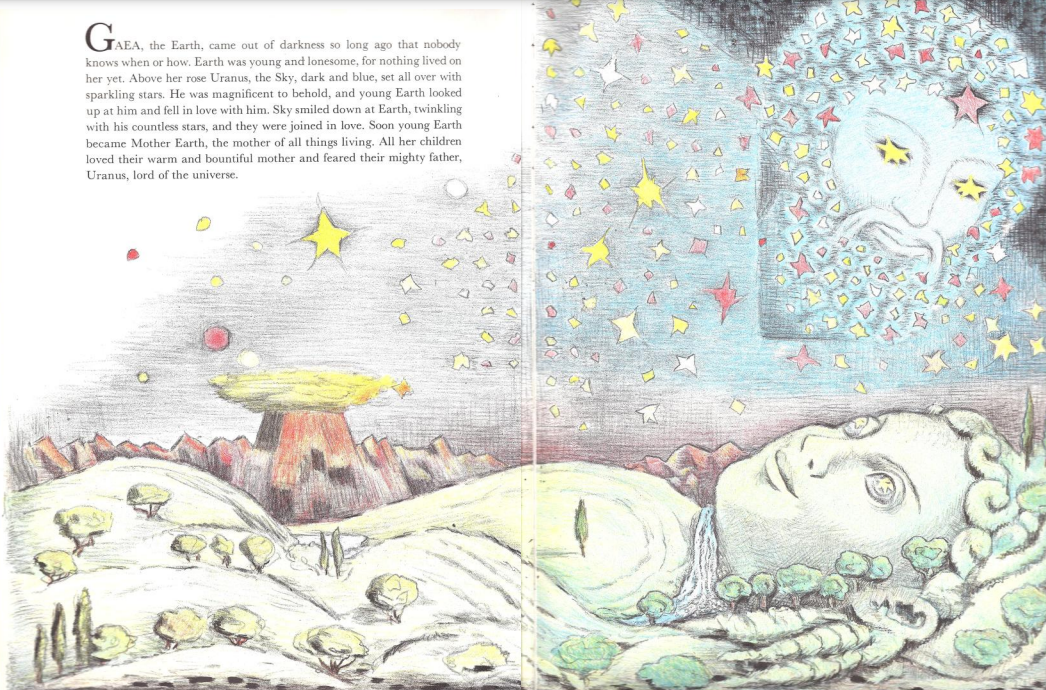
D’Aulaire, Ingri, and Edgar Parin D’Aulaire. D’Aulaires Book of Greek Myths. New York, United States, Penguin Random House, 1992.
In the above illustration, Uranus [the sky] is shown above Gaea [the earth].
Earth was the lower portion of the world, and Uranus was the sky dome above her.
This couple gave birth to all of the Titan gods and goddesses.
“The Titans were twelve in number; their names were: Oceanus, Ceos, Crios, Hyperion, Iapetus, Cronus, Theia, Rhea, Themis, Mnemosyne, Phœbe, and Tethys.” Berens, pg. 13.
Gaea and Uranus also gave birth to giants and other monstrous creatures.
“The Giants personified brute strength….There were three Giants, Briareus, Cottus, and Gyges, who each possessed a hundred hands and fifty heads, and were known collectively by the name of the Hecatoncheires, which signified hundred-handed. These mighty Giants could shake the universe and produce earthquakes….” Berens, pg. 13.
Because Uranus was pressed so very tightly against Gaea, their children could not be delivered. They were trapped inside Gaea. Soon, fighting erupted among the children inside Gaea, and Gaea was in agony. So that her children could finally emerge from within herself, Gaea convinced her unborn son Cronos to emerge and slay his father Uranus. He castrated his father [Uranus}, Uranus flinched, thus pulling himself away from or separating from Gaea. The Biblical account of the creation also mentions the fact that God separated the earth and the sky. Genesis 1:4.
When Cronus dethroned Uranus With that act, the second dynasty of Greek mythology evolved.
Second Dynasty of Ancient Greek Mythology
According to E. M. Berens, Cronos and Rhea were the leaders of the Second Dynasty of Ancient Greek Mythology. Cronos and Rhea were children of Gaea and Uranus. They were siblings.
Among their children were the following;
“Their children were three sons: Aïdes (Pluto), Poseidon (Neptune), Zeus (Jupiter), and three daughters: Hestia (Vesta), Demeter (Ceres), and Hera (Juno).” Berens, pg. 15.
Because Cronos feared that one of his children would usurp his throne, he devoured each of them. He did this immediately after they were born. But Rhea saved the last of her unborn children,
“Anxious to preserve the secret of his existence from Cronus, Rhea sent the infant Zeus secretly to Crete, where he was nourished, protected, and educated. A sacred goat, called Amalthea, supplied the place of his mother, by providing him with milk; nymphs, called Melissae, fed him with honey, and eagles and doves brought him nectar and ambrosia.[4] He was kept concealed in a cave in the heart of Mount Ida, and the Curetes, or priests of Rhea, by beating their shields together, kept up a constant noise at the entrance, which drowned the cries of the child and frightened away all intruders. Under the watchful care of the Nymphs the infant Zeus throve rapidly, developing great physical powers, combined with [16]extraordinary wisdom and intelligence. Grown to manhood, he determined to compel his father to restore his brothers and sisters to the light of day, and is said to have been assisted in this difficult task by the goddess Metis, who artfully persuaded Cronus to drink a potion, which caused him to give back the children he had swallowed. The stone which had counterfeited Zeus was placed at Delphi, where it was long exhibited as a sacred relic.” Berens, pgs. 15-16.
The Titanomachy – The War with Cronus
“Cronus was so enraged at being circumvented that war between the father and son became inevitable. The rival forces ranged themselves on two separate high mountains in Thessaly; Zeus, with his brothers and sisters, took his stand on Mount Olympus, where he was joined by Oceanus, and others of the Titans, who had forsaken Cronus on account of his oppressions. Cronus and his brother-Titans took possession of Mount Othrys, and prepared for battle. The struggle was long and fierce, and at length Zeus, finding that he was no nearer victory than before, bethought himself of the existence of the imprisoned Giants, and knowing that they would be able to render him most powerful assistance, he hastened to liberate them. He also called to his aid the Cyclops (sons of Poseidon and Amphitrite),[5] who had only one eye each in the middle of their foreheads, and were called Brontes (Thunder), Steropes (Lightning), and Pyracmon (Fire-anvil). They promptly responded to his summons for help, and brought with them tremendous thunderbolts which the Hecatoncheires, with their hundred hands, hurled down upon the enemy, at the same time raising mighty earthquakes, which swallowed up and destroyed all who opposed them. Aided by these new and powerful allies, Zeus now made a furious onslaught on his enemies, and so tremendous was the encounter that all nature is said to have throbbed in accord with this mighty effort of the celestial deities. The sea rose mountains high, and its angry billows [17]hissed and foamed; the earth shook to its foundations, the heavens sent forth rolling thunder, and flash after flash of death-bringing lightning, whilst a blinding mist enveloped Cronus and his allies.” Berens, pgs. 16-17.
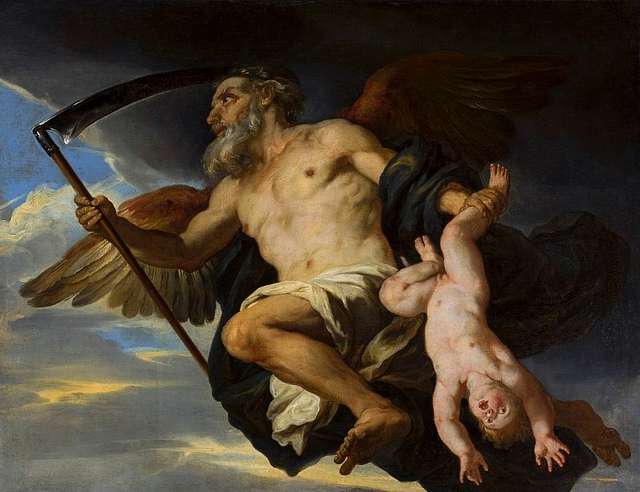
Cronos and His Child – painted by Giovanni Francesco Romanelli
Cronos is often depicted as an old man, holding a scythe, which represents time. Like his father, Cronos was dethroned by one of his sons Zeus, and the third dynasty began.
DIVISION OF THE WORLD.
When the testicles of Uranus were cast into the sea, another set of monstrous giants rose from the foam. Berens says that the legs of some of those monsters were snakes. These dreadful creatures would surface again in later history
“At last it was settled by lot that Zeus should reign supreme in Heaven, whilst Aïdes [Hades] governed the Lower World, and Poseidon had full command over the Sea, but the supremacy of Zeus was recognized in all three kingdoms, in heaven, on earth (in which of course the sea was included), and under the earth. Zeus held his court on the top of Mount Olympus, whose summit was beyond the clouds; the dominions of Aïdes [Hades] were the gloomy unknown regions below the earth; and Poseidon reigned over the sea. It will be seen that the realm of each of these gods was enveloped in mystery. Olympus was shrouded in mists, Hades was wrapt in gloomy darkness, and the sea was, and indeed still is, a source of wonder and deep interest. Hence we see that what to other nations were merely strange phenomena, served this poetical and imaginative people as a foundation upon which to build the wonderful stories of their mythology.” Berens, pg. 20.
The Gigantomachia War
“The division of the world being now satisfactorily arranged, it would seem that all things ought to have gone on smoothly, but such was not the case. Trouble arose in an unlooked-for quarter. The Giants, those hideous monsters (some with legs formed of serpents) who had sprung from the earth and the blood of Uranus, declared war against the triumphant deities of Olympus, and a struggle ensued, which, in consequence of Gæa having made these children of hers invincible as long as they kept their feet on the ground, was wearisome and protracted. … they were overcome, and this tedious war (which was called the Gigantomachia) at last came to an end. …One of the most powerful monsters who opposed Zeus in this [21]war was called Typhon or Typhœus. He was the youngest son of Tartarus and Gæa, and had a hundred heads, with eyes which struck terror to the beholders, and awe-inspiring voices frightful to hear. This dreadful monster resolved to conquer both gods and men, but his plans were at length defeated by Zeus, who, after a violent encounter, succeeded in destroying him with a thunderbolt, but not before he had so terrified the gods that they had fled for refuge to Egypt, where they metamorphosed themselves into different animals and thus escaped.” Berens, pgs. 20 – 21.
Some scholars believe that this was the time during which ancient Greek mythology and ancient Egyptian mythology merged.
That story is told in the following video:
Summary of the Video:
To earn the title of Master of Olympus, Zeus took many important steps, and he overcame many challenges. His story is one of an incredible conquest of power, dating back to time immemorial when the world began. Born from Chaos, Gaea – Mother Earth – who had mated with Uranus, the sky.
Zeus was the lord of the elements:
- The violent wind
- life-giving rain
By making decisions and settling disputes, he maintained social order.
He controlled lightning, which was the only weapon of mass destruction during his time
In one hand, he held a scepter made of cypress wood. It was a symbol of royalty.
In the other hand, he held the aegis, which he used to create thunderbolts.
His palace was on Mount Olympus.
His son Hephaestus was a blacksmith, and he forged the aegis, which Zeus used to create thunderbolts.
Out of the darkness came Gaea. She was the primordial goddess–the mother goddess–Mother Earth.
From the womb of Gaea came mountains, caves, planes, and rivers,
Eros appeared. Eros is the irresistible force that urged mankind to mate.
Gaea was the first being. She had no one to love–no one with which to mate.
She created Uranus, the sky, to be her mate.
Uranus lay on top of Gaia
Eros breathed desire into Uranus and he and Gaia made love for 1,000 days,
The Titans were born.
The Cyclops, the Giants, and the Hundred-Handed Ones were also their chilren.
All the children were trapped inside Gaia, and Uranus pressed down on her from above. He was smushing Gaea, and the situation was made worse because her children were trapped inside her.
If they tried to escape, Uranus shoved them back inside Gaea.
Gaea was exhausted and furious
She ordered her children to rebel against Uranus.
No one moved except Cronus, her youngest son, did as his mother asked, When Uranus came to make love, Chronos cut off his testicles and cast them into the sea.
Uranus flinched, and the sky and the earth separated
Some people say that the drops of rain were Uranus’s tears of regret.
Cronos mated with sister Rhea, but he devoured her children.
The cycle repeated itself.
While she was pregnant with Zeus, Rhea ran away. They escaped to the island of Crete, which is south of Greece.
Rhea gave Cronos a stone, Thinking it was his son, he ate it but didn’t die. Yet, because of that stone, Cronos regurgitated the rest of his children,
Zeus grew up in Crete, where he was served nectar and ambrosia. Gaea and the nymphs watched him
Mount Olympus – The Home of Zeus
“The Greeks believed that the home of this their mighty and all-powerful deity was on the top of Mount Olympus, that high and lofty mountain between Thessaly and Macedon, whose summit, wrapt in clouds and mist, was hidden from mortal view. It was supposed that this mysterious region, which even a bird could not reach, extended beyond the clouds right into Aether, the realm of the immortal gods. The poets describe this ethereal atmosphere as bright, glistening, and refreshing, exercising a peculiar, gladdening influence over the minds and hearts of those privileged beings permitted to share its delights. Here youth never ages, and the passing years leave no traces on its favoured inhabitants. On the cloud-capped summit of Olympus was the palace of [28]Zeus and Hera, of burnished gold, chased silver, and gleaming ivory. Lower down were the homes of the other gods, which, though less commanding in position and size, were yet similar to that of Zeus in design and workmanship, all being the work of the divine artist Hephæstus. Below these were other palaces of silver, ebony, ivory, or burnished brass, where the Heroes, or Demi-gods, resided.” Berens, pgs. 27-28.
Wives of Zeus
“Zeus had seven immortal wives, whose names were Metis, Themis, Eurynome, Demeter, Mnemosyne, Leto, and Hera.
“METIS, his first wife, was one of the Oceanides or sea-nymphs. She was the personification of prudence and wisdom, a convincing proof of which she displayed in her successful administration of the potion which caused Cronus to yield up his children. She was endowed with the gift of prophecy, and foretold to Zeus that one of their children would gain ascendency over [31]him. In order, therefore, to avert the possibility of the prediction being fulfilled he swallowed her before any children were born to them. Feeling afterwards violent pains in his head, he sent for Hephæstus, and ordered him to open it with an axe. His command was obeyed, and out sprang, with a loud and martial shout, a beautiful being, clad in armour from head to foot. This was Athene (Minerva), goddess of Armed Resistance and Wisdom.
“THEMIS was the goddess of Justice, Law, and Order.
“EURYNOME was one of the Oceanides, and the mother of the Charites or Graces.
DEMETER,[13] the daughter of Cronus and Rhea, was the goddess of Agriculture.
MNEMOSYNE, the daughter of Uranus and Gæa, was the goddess of Memory and the mother of the nine Muses.
“LETO (Latona) was the daughter of Cœus and Phœbe. She was gifted with wonderful beauty, and was tenderly loved by Zeus, but her lot was far from being a happy one, for Hera, being extremely jealous of her, persecuted her with inveterate cruelty, and sent the dreadful serpent Python[14] to terrify and torment her wherever she went. But Zeus, who had observed with the deepest compassion her weary wanderings and agonized fears, resolved to create for her some place of refuge, however humble, where she might feel herself safe from the venomous attacks of the serpent. He therefore brought her to Delos, a floating island in the Ægean Sea, which he made stationary by attaching it with chains of adamant to the bottom of the sea. Here she gave birth to her twin-children, Apollo and Artemis (Diana), two of the most beautiful of the immortals.
“According to some versions of the story of Leto, Zeus transformed her into a quail, in order that she might thus elude the vigilance of Hera, and she is said to have [32]resumed her true form when she arrived at the island of Delos.
“HERA, being the principal wife of Zeus and queen of heaven….” Berens, pgs. 30-32.
“In addition to the seven immortal wives of Zeus, he was also allied to a number of mortal maidens whom he visited under various disguises, as it was supposed that if he revealed himself in his true form as king of heaven the splendour of his glory would cause instant destruction to mortals. The mortal consorts of Zeus have been such a favourite theme with poets, painters, and sculptors, that it is necessary to give some account of their individual history. Those best known are Antiope, Leda, Europa, Callisto, Alcmene, Semele, Io, and Danae.” Berens, pg. 32
“EUROPA was the beautiful daughter of Agenor, king of Phœnicia. She was one day gathering flowers with her companions in a meadow near the sea-shore, when Zeus, charmed with her great beauty, and wishing to win her love, transformed himself into a beautiful white bull, and trotted quietly up to the princess, so as not to alarm her. Surprised at the gentleness of the animal, and admiring its beauty, as it lay placidly on the grass, she caressed it, crowned it with flowers, and, at last, playfully seated herself on its back. Hardly had she done so than the disguised god bounded away with his lovely burden, and swam across the sea with her to the island of Crete.
Europa was the mother of Minos, Aeacus, and Rhadamanthus. Minos, who became king of Crete, was celebrated for his justice and moderation, and after death he was created one of the judges of the lower world, which office he held in conjunction with his brothers.[35]
CALLISTO, the daughter of Lycaon, king of Arcadia, was a huntress in the train of Artemis, devoted to the pleasures of the chase, who had made a vow never to marry; but Zeus, under the form of the huntress-goddess, succeeded in obtaining her affections. Hera, being extremely jealous of her, changed her into a bear, and caused Artemis (who failed to recognize her attendant under this form) to hunt her in the chase, and put an end to her existence. After her death she was placed by Zeus among the stars as a constellation, under the name of Arctos, or the bear.” Berens, pgs. 34-35
“IO, daughter of Inachus, king of Argos, was a priestess of Hera. She was very beautiful, and Zeus, who was much attached to her, transformed her into a white cow, in order to defeat the jealous intrigues of Hera, who, however, was not to be deceived. Aware of the stratagem, she contrived to obtain the animal from Zeus, and placed her under the watchful care of a man called Argus-Panoptes, who fastened her to an olive-tree in the grove of Hera. He had a hundred eyes, of which, when asleep, he never closed more than two at a time; being thus always on the watch, Hera found him extremely useful in keeping guard over Io. Hermes, however, by the command of Zeus, succeeded in putting all his eyes to sleep with the sound of his magic lyre, and then, taking advantage of his helpless condition, slew him. The story goes, that in commemoration of the services which Argus had rendered her, Hera placed his eyes on the tail of a peacock, as a lasting memorial of her gratitude. Ever fertile in resource, Hera now sent a gadfly to worry and torment the unfortunate Io incessantly, and she wandered all over the world in hopes of escaping from her tormentor. At length she reached Egypt, where she found rest and freedom from the persecutions of her enemy. On the banks of the Nile she resumed her original form and gave birth to a son called Epaphus, who afterwards became king of Egypt, and built the famous city of Memphis.
“DANAE.—Zeus appeared to Danae under the form of a shower of gold. (Further details concerning her will be found in the legend of Perseus.)” Berens, pg. 36
HERA
“Hera, the eldest daughter of Cronus and Rhea, was born at Samos, or, according to some accounts, at Argos, and was reared by the sea-divinities Oceanus and Tethys, who were models of conjugal fidelity.[16] She was the [39]principal wife of Zeus, and, as queen of heaven, participated in the honours paid to him, but her dominion only extended over the air (the lower aërial regions). Hera appears to be the sublime embodiment of strict matronly virtue, and is on that account the protectress of purity and married women. Faultless herself in her fidelity as a wife, she is essentially the type of the sanctity of the marriage tie, and holds in abhorrence any violation of its obligations. So strongly was she imbued with this hatred of any immorality, that, finding herself so often called upon to punish the failings of both gods and men in this respect, she became jealous, harsh, and vindictive. Her exalted position as the wife of the supreme deity, combined with her extreme beauty, caused her to become exceedingly vain, and she consequently resented with great severity any infringement on her rights as queen of heaven, or any apparent slight on her personal appearance.
“The following story will signally illustrate how ready she was to resent any slight offered to her.
At the marriage of the sea-nymph Thetis with a mortal called Peleus, all the gods and goddesses were present, except Eris (the goddess of Discord). Indignant at not being invited, she determined to cause dissension in the assembly, and for this purpose threw into the midst of the guests a golden apple with the inscription on it “For the Fairest.” Now, as all the goddesses were extremely beautiful, each claimed the apple; but at length, the rest having relinquished their pretensions, the number of candidates was reduced to three, Hera, Athene, and Aphrodite, who agreed to appeal to Paris for a settlement of this delicate question, he being noted for the wisdom he had displayed in his judgment upon several occasions. Paris was the son of Priam, king of Troy, who, ignorant of his noble birth, was at this time feeding his flocks on Mount Ida, in Phrygia. Hermes, as messenger of the gods, conducted the three rival beauties to the young shepherd, and with breathless anxiety they awaited his decision. Each fair candidate endeavoured [40]to secure his favour by the most tempting offers. Hera promised him extensive dominions; Athene, martial fame and glory; and Aphrodite, the loveliest woman in the world. But whether he really considered Aphrodite the fairest of the three, or preferred a beautiful wife to fame and power, we cannot tell; all we know is that to her he awarded the golden apple, and she became ever after universally acknowledged as the goddess of beauty. Hera, having fully expected that Paris would give her the preference, was so indignant that she never forgave him, and not only persecuted him, but all the family of Priam, whose dreadful sufferings and misfortunes during the Trojan war were attributed to her influence. In fact, she carried her animosity to such an extent that it was often the cause of domestic disagreements between herself and Zeus, who espoused the cause of the Trojans.
“Among the many stories of these frequent quarrels there is one connected with Heracles, the favourite son of Zeus, which is as follows:—Hera having raised a storm at sea in order to drive him out of his course, Zeus became so angry that he hung her in the clouds by a golden chain, and attached heavy anvils to her feet. Her son Hephæstus tried to release his mother from her humiliating position, for which Zeus threw him out of heaven, and his leg was broken by the fall.
“Hera, being deeply offended with Zeus, determined to separate herself from him for ever, and she accordingly left him and took up her abode in Eubœa. Surprised and grieved at this unlooked-for desertion, Zeus resolved to leave no means untried to win her back again. In this emergency he consulted Cithaeron, king of Platea, who was famed for his great wisdom and subtlety. Cithaeron advised him to dress up an image in bridal attire and place it in a chariot, announcing that this was Platea, his future wife. The artifice succeeded. Hera, incensed at the idea of a rival, flew to meet the procession in great anger, and seizing the supposed bride, she furiously attacked her and dragged off her nuptial attire. Her delight on discovering the deception was so great that a [41]reconciliation took place, and, committing the image to the flames, with joyful laughter she seated herself in its place and returned to Olympus.
“Hera was the mother of Ares (Mars), Hephæstus, Hebe, and Eileithyia. Ares was the god of War; Hephæstus, of Fire; Hebe, of Youth; and Eileithyia presided over the birth of mortals.
“Hera dearly loved Greece, and indeed always watched over and protected Greek interests, her beloved and favourite cities being Argos, Samos, Sparta, and Mycenæ.
“Her principal temples were at Argos and Samos. From a remote period she was greatly venerated at Olympia, and her temple there, which stood in the Altis or sacred grove, was five hundred years older than that of Zeus on the same spot. Some interesting excavations which are now going on there have brought to light the remains of the ancient edifice, which contains among other treasures of antiquity several beautiful statues, the work of the famous sculptors of ancient Greece. At first this temple was built of wood, then of stone, and the one lately discovered was formed of conglomerate of shells.
“In the Altis races were run by young maidens in honour of Hera, and the fleetest of foot received in token of her victory an olive-wreath and a piece of the flesh of the sacrifices. These races, like the Olympic Games, were celebrated at intervals of four years, and were called Heræ. A beautiful robe, woven by sixteen women chosen from the sixteen cities of Elis, was always offered to Hera on these [42]occasions, and choral songs and sacred dances formed part of the ceremonies.
“Hera is usually represented seated on a throne, holding a pomegranate in one hand and a sceptre surmounted by a cuckoo in the other. She appears as a calm, dignified matron of majestic beauty, robed in a tunic and mantle, her forehead is broad and intellectual, her eyes large and fully opened, and her arms dazzlingly white and finely moulded.
“The finest statue of this divinity was that by Polycletus at Argos.
“Her attributes are the diadem, veil, sceptre, and peacock.
“The first day of every month a ewe-lamb and sow were sacrificed to Hera. The hawk, goose, and more particularly the peacock[17] were sacred to her. Flocks of these beautiful birds generally surround her throne and draw her chariot, Iris, the Rainbow, being seated behind her.
“Her favourite flowers were the dittany, poppy, and lily.” Berens, pgs. 38-42